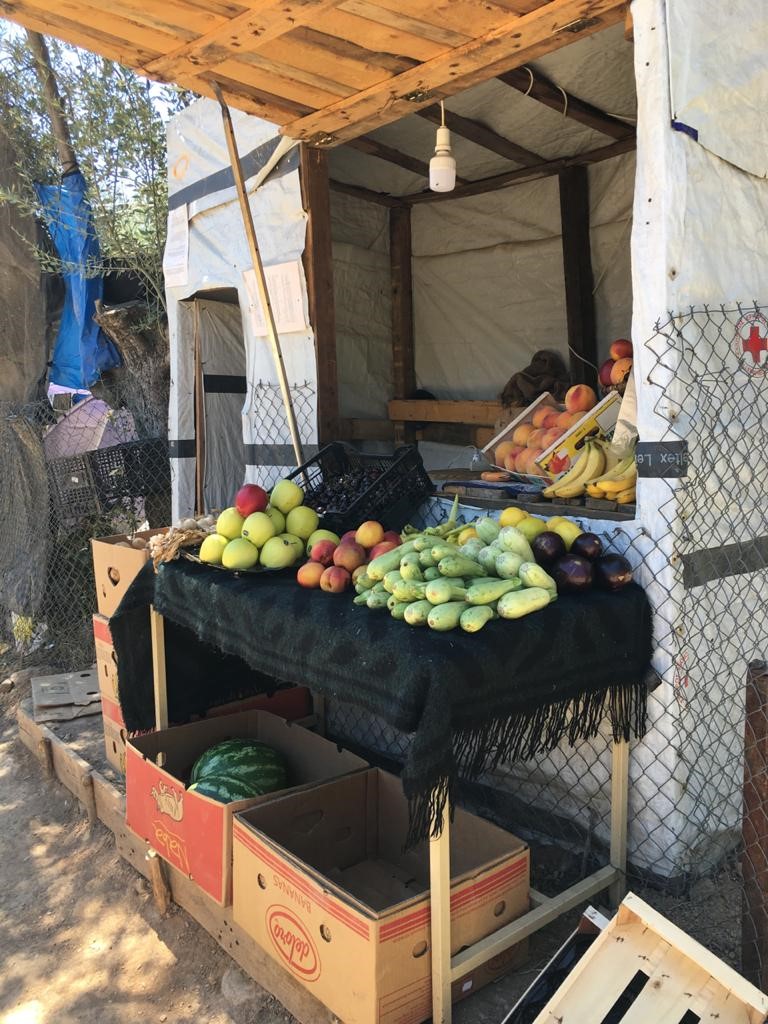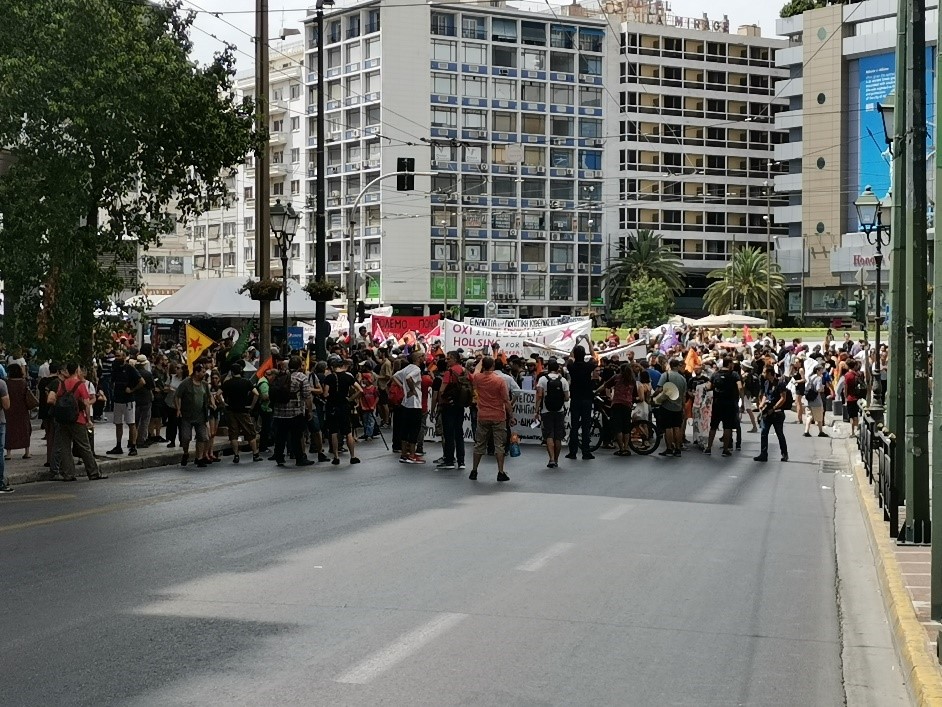TRAFIG Fieldwork in Greece
In Greece, the restrictions applied during Covid-19 pandemic along with the two new Laws adopted since the beginning of 2020, have further tightened migration controls, protection and reception systems, and asylum procedures. Although some expert interviews took place online in May, fieldwork in Greece essentially resumed at mid-June, after the termination of the two-month lockdown (although lockdown measures are still in place in some camps in the mainland and in all hot-spots on the islands, strengthening restrictions of movement and marginalization).
Eva Papatzani, Alexandra Siotou, Filyra Vlastou and Panos Hatziprokopiou from the TRAFIG Team in Greece share their insights from the fieldwork in the Aegean islands, Athens and Thessaloniki:
A few days ago, the infamous camp Moria on Lesvos burned down, leaving 13,000 persons without shelter. Did you see such an incident looming on the Horizon?
Panos: After 5 years of functioning as an internal European borderland, the local communities, especially in Lesvos, seem to have reached the limits of their tolerance, despite numerous examples of active humanism, help and solidarity during and after 2015-16. Following the governments’ violent attempts to establish mass detention centres in February, as well as the incidents at the Turkish-Greek land borders in early March, extreme-right violence targeting migrants and refugees as well as NGOs, humanitarian workers and solidarity activists has been on the rise. While these notes are being finalized, the announcement of 35 confirmed COVID-19 positive cases in the infamous Moria camp on Lesvos on 8 September, and the authorities’ choice to enclose the camp and confine its residents without any health facilities or other provisions in place, led to angry reactions that caused – in a so far underdetermined way - a series of fires starting early morning on 9 September, that devastated the camp and left nearly 13,000 people without shelter.
TRAFIG fieldwork in the north eastern Aegean islands has started in June 2020. How was the fieldwork organised and how did it progress in the context of the pandemic?
Filyra: In the north eastern Aegean islands of Chios and Lesvos, with the exception of a couple of expert interviews that took place virtually in June, the fieldwork started at mid-July when with the absence of any confirmed COVID-19 cases in the camps, the movement restrictions for its residents were loosen. Until mid-August, when the first phase of fieldwork was completed, a total of 18 interviews with displaced persons, experts, locals and network contacts were conducted, along with numerous informal talks and other ethnographic material. One of the main challenges of conducting fieldwork in COVID times was that the increased cautiousness on the security precautions such as distancing and the use of masks undermines the contact which is essential to build the trust needed in ethnographic methodologies.
Are there any striking insights from the interviews in Chios and Lesvos so far?
Filyra: To note some of the primary findings, protracted displacement in the case of Chios and Lesvos is principally linked to protracted livelihood insecurity, due to the dire living conditions, especially for those staying in camps. Furthermore, it is linked to legal insecurity because of the significant delays in the examination process of international protection applications.
Over the course of this year, the already precarious situations for persons in the camps has been deteriorating continuously due to multiple burdens. Next to COVID-19, the massive overcrowding has been one of these factors. Which impacts did the most recent developments have?
Filyra: Since March, mobility restrictions (both local and translocal) for migrants staying in Chios and Lesvos worsened, causing their further entrapment and the overcrowding of camps/islands. This was caused by a number of policies (i.e. geographical restriction) and recent stricter institutional – national or European- practices (limitation of transfers under the family reunification directive, increased number of detentions). More so, the new legislation (L4636/2019) extended the restrictions of free movement for more groups of migrants (i.e. vulnerable persons, Dublin cases) penalizing non-compliance for the first-time. On top of that, the COVID-19 outbreak and the imposed restrictions further aggravated migrants’ possibilities of movement. Revealing of this is that, although movement restrictions were lifted for the general population on the 4th of May, they remained in place for migrants in all island camps and a number in mainland camps.
How have refugees and asylum seekers been coping with the increasing challenges in their everyday life?
Filyra: The Covid19 outbreak worsened migrants’ everyday life in general, undermining their legal rights, their access to asylum procedures and to health services. On top of that, displaced persons face segregation (camps are far from urban centres) while in the last months xenophobia and racist practices prevail in the island communities targeting displaced persons, NGO’s staff and solidarity people. In response to this situation, migrants are employing a variety of coping strategies. For instance, inside the camps, informal economies have been developed. Before the destruction of the camp due to the fires, shops in Moria provided different kind of goods, while in Chios, young migrants supply with food and water from the nearby city co-residents with limited movement capacities. Moreover, in light of the Covid19 restrictions, migrants in Moria had formed self-organised groups to cope with the lack of water, or to raise awareness about health issues. During the confinement, connectivity among migrants, or between migrants and support organisations (e.g. NGOs) relied on digital social networks. In particular, NGOs providing legal aid or language courses adjusted their programs using digital social networks or free messaging apps in order to remain in contact and assure the continuity of assistance for displaced people inside the camps.
 Makeshift shop in Moria camp, Lesvos. 4 August 2020. Photo by Filyra Vlastou.
Makeshift shop in Moria camp, Lesvos. 4 August 2020. Photo by Filyra Vlastou.
How has the fieldwork proceeded in Athens, and what were the impacts of COVID-19?
Eva: In Athens, digital ethnography through photo-voice techniques have been combined with biographic interviews with refugees and asylum seekers, a method that can facilitate fieldwork during the pandemic, as proposed by FIERI colleagues. Interviews with asylum seekers in Athens, as well as the material (both photos and videos) they shared about their lives during quarantine reveal their restrictions of movement in the city, that were strengthened by intense police controls of not only Covid-related papers for the permission of movement, but also asylum documents. In many cases, fines were imposed to asylum seekers and refugees, due to the lack of Covid-related papers, increasing their precarious and marginal situation.
How have recent developments regarding reception and protection programs affected refugees and asylum seekers?
Eva: Through the new legislation, specific terms and conditions are defined for the first time as regards the termination of reception and protection provision for asylum seekers and recognized refugees. As such, the exits from the ESTIA accommodation program for asylum seekers (in apartments and hotels) have been multiplied, as the time limit for the termination of provisions for people whose asylum case is concluded is specified to just one month after the decision. Currently, thousands of recognized refugees risk remaining – or are already - homeless. Since late May, there have been numerous cases of “non-compliant” (refugees who refuse to leave the ESTIA apartments), as well as some organized protests, under the slogan “I am not leaving my home”. Despite repeated evacuations by the police (the latest one on 8 September), until these days, numerous recognized refugees remain homeless at Victoria square in central Athens, after their transfer from the hotspots of the eastern Aegean islands.
 Demonstration in Athens against the exits from ESTIA accommodation. 20 June 2020. Photo by Eva Papatzani.
Demonstration in Athens against the exits from ESTIA accommodation. 20 June 2020. Photo by Eva Papatzani.
How has the fieldwork progressed in Thessaloniki? Based on your insights so far, what can be said about the relationships and interactions that refugees and asylum seekers are part of?
Alexandra: In Thessaloniki, field research essentially started in June and took place at refugee camps around the city, as well as refugees’ social and day care centers, Arabic restaurants, Asian grocery stores and coffee shops located mainly in the center of the city, where migrants, refugees and asylum seekers - mostly men - gather around and spend their “free” time. Through an ethnographic approach, we have been offered the opportunity to observe refugees’ interactions within their ethnic communities and their local networks of support, and found out that connectivity - being in contact - and visibility - being always present - play a significant role in the way refugees cope with hardships and seek work, shelter, information about the new migration regulations, or how to travel to “Europe”.
Which challenges do refugees and asylum seekers in Thessaloniki face while regulating their everyday lives?
Alexandra: Based on refugees’ testimonies, one of their main concerns and daily practices is to learn how to navigate through regimes of aid and asylum, in order to make good use - as much as possible - of the services provided by the state and non-governmental organizations, so that they could improve their everyday living conditions. However, interviews with experts reveal that protection regimes hinder refugees’ integration into the Greek society worsening refugees’ precarity. It is worth noting the lack of interactions and contacts between the host society and refugees partly due to the language barrier. Most of the refugees don’t speak English and weren’t interested in learning the Greek language, a fact that actually affected considerably the field research. The aforementioned exits from the ESTIA accommodation and support programme remains a concern here too, while the numbers of people sheltered in camps around the city has increased due to transfers from the islands.
Research in Greece is managed by TRAFIG partner Aristotle University of Thessaloniki.
The views and opinions expressed in this blog do not necessarily reflect the opinion of the TRAFIG Consortium or the European Commission (EC). TRAFIG is not responsible for any use that may be made of the information contained therein.